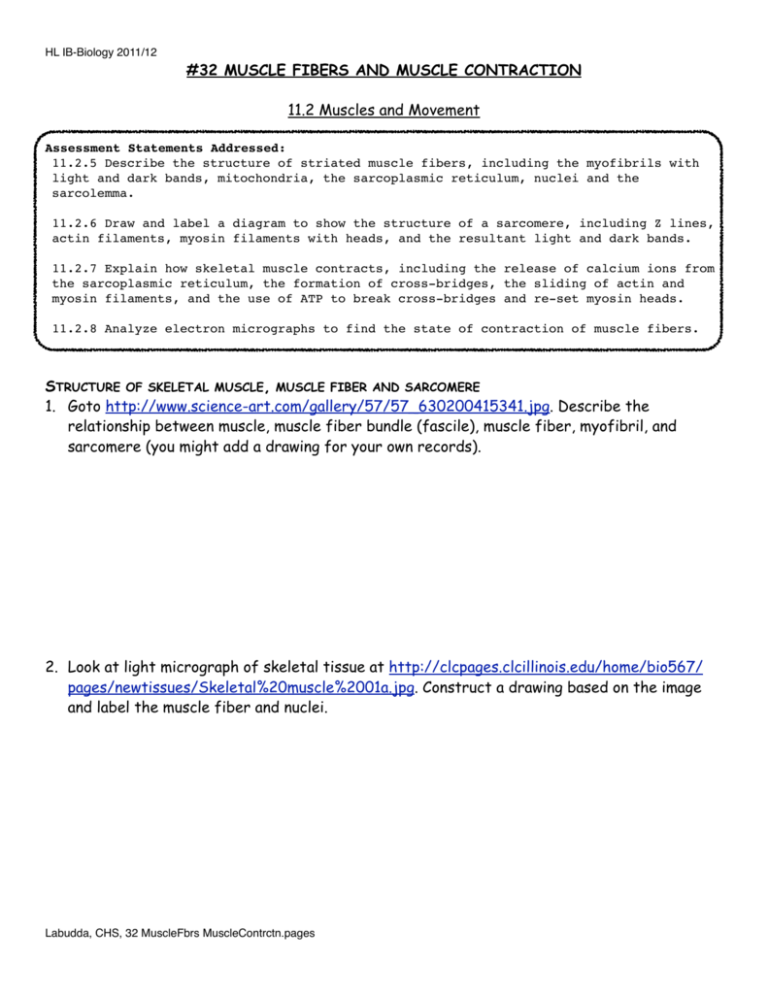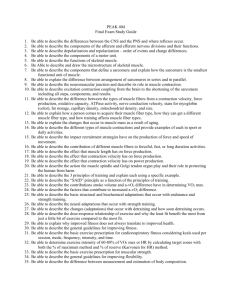32 MuscleFbrs MuscleContrctn
advertisement

HL IB-Biology 2011/12 #32 MUSCLE FIBERS AND MUSCLE CONTRACTION 11.2 Muscles and Movement Assessment Statements Addressed: 11.2.5 Describe the structure of striated muscle fibers, including the myofibrils with light and dark bands, mitochondria, the sarcoplasmic reticulum, nuclei and the sarcolemma. 11.2.6 Draw and label a diagram to show the structure of a sarcomere, including Z lines, actin filaments, myosin filaments with heads, and the resultant light and dark bands. 11.2.7 Explain how skeletal muscle contracts, including the release of calcium ions from the sarcoplasmic reticulum, the formation of cross-bridges, the sliding of actin and myosin filaments, and the use of ATP to break cross-bridges and re-set myosin heads. 11.2.8 Analyze electron micrographs to find the state of contraction of muscle fibers. STRUCTURE OF SKELETAL MUSCLE, MUSCLE FIBER AND SARCOMERE 1. Goto http://www.science-art.com/gallery/57/57_630200415341.jpg. Describe the relationship between muscle, muscle fiber bundle (fascile), muscle fiber, myofibril, and sarcomere (you might add a drawing for your own records). 2. Look at light micrograph of skeletal tissue at http://clcpages.clcillinois.edu/home/bio567/ pages/newtissues/Skeletal%20muscle%2001a.jpg. Construct a drawing based on the image and label the muscle fiber and nuclei. Labudda, CHS, 32 MuscleFbrs MuscleContrctn.pages 3. Define muscle fiber. 4. Outline what is special about a muscle cell. 5. Look at an electron micrograph of skeletal muscle tissue at http://course1.winona.edu/ sberg/IMAGES/muscle1.gif. Construct a drawing of a muscle fiber based on the image and label the muscle fiber, sarcomere, Z-line, I-band, A-band, M-line, H-band, light band, dark band and mitochondria. 6. Construct a labeled diagram of a sarcomere showing the arrangement of thin and thick filaments. Indicate the dark and light band. 7. State what molecules make up the thin and thick filaments. 8. Construct a labeled diagram to show in more detail the structure of actin, myosin, troponin and tropomyosin and their relative position to each other. 9. Look at electron micrograph showing a relaxed and contracted sarcomere at http:// www.mrothery.co.uk/images/Imag109.gif. Determine the differences between a contracted and relaxed sarcomere. 10. Watch an animation of a sarcomere shortening at http://msjensen.cehd.umn.edu/1135/Links/ Animations/Flash/0008-swf_sarcomere_shor.swf. Explain what makes the sarcomere the contractile unit of a muscle fiber. MUSCLE CONTRACTION 1. Use the interactive activity at http://www.brookscole.com/chemistry_d/templates/student_resources/ shared_resources/animations/muscles/muscles.swf to review the structure of a muscle fiber and sarcomere, and to study the molecular mechanisms of muscle contraction. 2. Draw muscle fibers label all parts as shown in animation. 3. In order to coordinate movement, each muscle fiber is innovated by one neuron. The connection between neuron and muscle fiber is called motor end-plate. Look at the light micrograph of neurons and skeletal muscle at http://education.vetmed.vt.edu/Curriculum/VM8054/ Labs/Lab10/IMAGES/MOTOR%20END%20PLATES%20SMALL%201.jpg. You might also at this point review neurons and action potential. DRAW THE IMAGE AND LABEL IT. 4. Watch the following animations and use your textbook and other on-line material of your choosing, to study the sliding filament theory of muscle contraction. Complete figure 1 and the problems that follow as a review. http://msjensen.cehd.umn.edu/1135/Links/Animations/Flash/0010-swf_action_potenti.swf http://msjensen.cehd.umn.edu/1135/Links/Animations/Flash/0011-swf_breakdown_of_a.swf http://cellimages.ascb.org/cdm4/item_viewer.php?CISOROOT=/p4041coll12&CISOPTR=101&CISOBOX=1&REC=2 5. Complete figure 1 by drawing into the boxes the molecular events taking place between actin and myosin during one cycle of muscle contraction. The four main steps are titled, ‘CrossBridge Formation’, ‘ATP-binding’, ‘Release of ADP and Pi’, and ‘ATP hydrolysis’ (not listed in order). Annotate each drawing with a description of the events. 4. ______________________________ 3. ______________________________ 1.______________________________ 2. ____________________________ Figure 1: The Contractile Cycle 1. Explain how Ca2+ controls the contractile cycle. 2. Describe how the release of Ca2+ is controlled by a motor neuron. 3. Determine how the structure of the muscle cell is related to its function. 4. Determine the molecular mechanism for rigor mortis.








